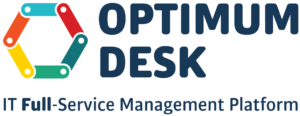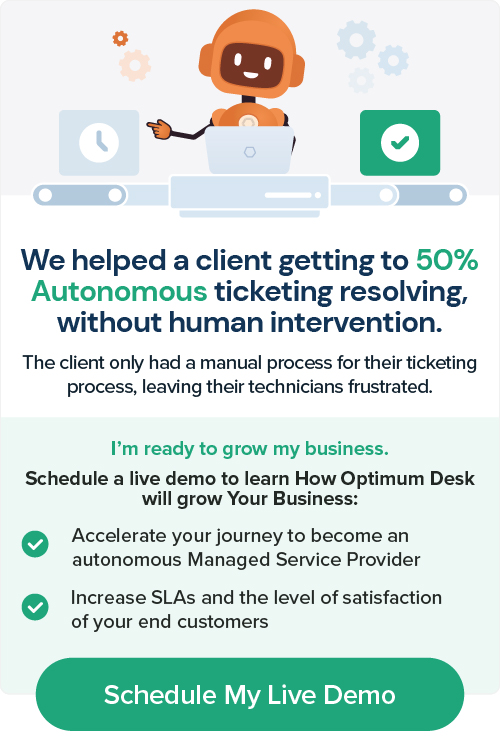For many organizations, knowledge management is often considered a technological issue. This is why when implementing knowledge management, execution is often unsuccessful because the processes and types of articles created are too complicated for people to use.
Nowadays, knowledge management requires a new understanding of the organizational paradigm of change management. Because people work in hybrid environments, the ultimate goal is to have an enterprise-wide system where teams and people feel free to analyze, observe, and share knowledge between teams. Ultimately, this will lead to an exponential increase in the productivity of your technicians and will produce more value throughout the company.
3 steps for transforming the ITSM knowledge management process
Imagine a scenario in which a Service Desk technician helps a customer solve a problem. The customer is blocked by an extremely technical problem that precedes the date of accession of your technician. As a result, she begins to look for a solution in the company’s knowledge base. And exactly when it meets the following set of impediments:
- The UI platform in the knowledge management tool is difficult to navigate. The technician has to spend a lot of time just going through unrelated blogs, guides, and directories.
- The search tool is not very useful. Therefore, she has to go back manually a few years ago and find a relevant entry that can help her solve the client’s query.
- Finally, find a blog post. The problem is – it has 12 pages. The client needs a quick resolution, and now the technician has to go through the whole blog to find that line of solution.
Finally, even if the technician managed to do his job and offer a resolution, the platform will show that it took a long time to do it and reached a rating lower than average.
-
Reengineer the process to give priority to technicians.
As you have seen in the case presented above, technicians are often under extraordinary pressure. On the one hand, a client is trying to solve a problem. In most cases, a business process has been stopped because the customer cannot continue to work until the technical issue is resolved. Therefore, the technician must be fast and efficient.
On the other hand, the technician has difficulty going through dozens of articles, e-books, and dated guides, while trying to find a simple solution to a complex problem. There needs to be a better way to do this. And here it is. Map each point of contact between the technician and the knowledge base and resolve the friction between these points of contact. Here’s what the roadmap will look like:
- Previous similarly resolved tickets are treasures: Most of the process of transforming knowledge management pays special attention to content and information. While you can transform the entire knowledge management platform, your tool should also give your technicians the ability to search similarly resolved previous tickets to save an extraordinary amount of time.
- Take complete control: The only thing more harmful than a complex article is an inaccurate article. Even the smallest mistakes in the articles can lead to false advice published by the technician. Therefore, through your ITSM tool, you should create multi-step approval workflows with customizable rules that require approvals and authorization before publishing new articles or changes to older versions. This way, you can have total control over the content that is consumed.
-
Optimize the knowledge base user experience.
Think about the daily search experience of your technicians and users. They are accustomed to a “Google” search experience and expect to find the same thing in the knowledge base. Thus, the user interface of the ITSM knowledge base needs to be optimized to support powerful search functionality.
- Provide powerful contextual search capabilities: With universal knowledge base advanced search capabilities, technicians and end-users can search for answers using predefined search options and keywords and save time and effort navigating the knowledge base to discover relevant information in terms of articles, solutions, FAQs, and tutorials.
- Promote self-service among users: Consider how and through which channel end-user knowledge is transmitted. A self-service portal is a central body of information through which users can find information on how to solve common problems that have arisen before. The self-service portal should ideally carry all the information and make it available to users so that they can solve common problems without involving a technician, thus promoting self-help.
-
Create continuous feedback loops to improve your knowledge base
The biggest challenge of having a knowledge base is that it requires constant updates. As your systems, technology, and operations evolve, a lot of the information you’ve previously published will become obsolete. Even if this knowledge has been made accessible, available in a pleasant format, and helped in the past – it will no longer be useful. Here’s how to effectively store your relevant knowledge:
Create a dialogue between subject matter experts and technicians: Allow knowledge base users to comment and suggest changes. Having a feedback system in the form of comments and suggestions from technicians will help keep the content fresh, relevant, and more in line with their requirements.
Look for feedback, even if it’s binary: Something as simple as a thumbs up or an enterprise-scale thumb can show you whether or not the content has become obsolete. Ask users for feedback on the content they consume. In this way, the responsibility for maintaining relevance across the spectrum of knowledge is shared between a large set of stakeholders instead of a focused team.
As you may have noticed by now, when you have the right ITSM tool, it doesn’t take much to build and maintain an effective knowledge management system. As soon as you capitalize on the power of knowledge transfer and self-service in your organization, you’ll see a sudden increase in first call resolutions, technical productivity, and user satisfaction. To transform your knowledge management today, download the Optimum Desk ITSM Platform file for free for 30 days.


